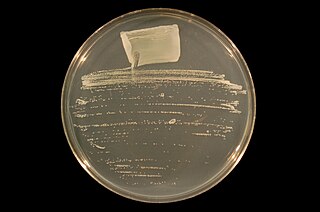Related Research Articles

Rhizobium is a genus of Gram-negative soil bacteria that fix nitrogen. Rhizobium species form an endosymbiotic nitrogen-fixing association with roots of (primarily) legumes and other flowering plants.

Agrobacterium is a genus of Gram-negative bacteria established by H. J. Conn that uses horizontal gene transfer to cause tumors in plants. Agrobacterium tumefaciens is the most commonly studied species in this genus. Agrobacterium is well known for its ability to transfer DNA between itself and plants, and for this reason it has become an important tool for genetic engineering.

Ensifer meliloti are an aerobic, Gram-negative, and diazotrophic species of bacteria. S. meliloti are motile and possess a cluster of peritrichous flagella. S. meliloti fix atmospheric nitrogen into ammonia for their legume symbionts, such as alfalfa. S. meliloti forms a symbiotic relationship with legumes from the genera Medicago, Melilotus and Trigonella, including the model legume Medicago truncatula. This symbiosis promotes the development of a plant organ, termed a root nodule. Because soil often contains a limited amount of nitrogen for plant use, the symbiotic relationship between S. meliloti and their legume hosts has agricultural applications. These techniques reduce the need for inorganic nitrogenous fertilizers.

Bradyrhizobium is a genus of Gram-negative soil bacteria, many of which fix nitrogen. Nitrogen fixation is an important part of the nitrogen cycle. Plants cannot use atmospheric nitrogen (N2); they must use nitrogen compounds such as nitrates.

Ensifer is a genus of nitrogen-fixing bacteria (rhizobia), three of which have been sequenced.
Neorhizobium galegae is a Gram negative root nodule bacteria. It forms nitrogen-fixing root nodules on legumes in the genus Galega.
Pararhizobium giardinii is a Gram negative root nodule bacteria. It forms nitrogen-fixing root nodules on legumes, being first isolated from those of Phaseolus vulgaris.
Rhizobium gallicum is a Gram-negative root-nodule bacterium. It forms nitrogen-fixing root nodules on legumes, being first isolated from those of Phaseolus vulgaris.
Mesorhizobium tianshanense, formerly known as Rhizobium tianshanense, is a Gram negative species of bacteria found in the root nodules of many plant species. Its type strain is A-1BS.
Mesorhizobium plurifarium is a species of root nodule bacteria first isolated from Acacia species in Senegal. Its type strain is ORS 1032.
Rhizobium hainanense is a Gram negative root nodule bacteria. Strain CCBAU 57015 (166) is the type strain.
Rhizobium mongolense is a Gram negative root nodule bacteria, which nodulates and forms nitrogen-fixing symbioses with Medicago ruthenica. Its type strain is USDA 1844.
Mesorhizobium mediterraneum is a bacterium from the genus Mesorhizobium, which was isolated from root nodule of the Chickpea in Spain. The species Rhizobium mediterraneum was subsequently transferred to Mesorhizobium mediterraneum. This species, along with many other closely related taxa, have been found to promote production of chickpea and other crops worldwide by forming symbiotic relationships.
Allorhizobium vitis is a plant pathogen that infects grapevines. The species is best known for causing a tumor known as crown gall disease. One of the virulent strains, A. vitis S4, is responsible both for crown gall on grapevines and for inducing a hypersensitive response in other plant species. Grapevines that have been affected by crown gall disease produce fewer grapes than unaffected plants. Though not all strains of A. vitis are tumorigenic, most strains can damage plant hosts.
Azorhizobium doebereinerae is a species of bacteria in the family Xanthobacteraceae. Strains of this species were originally isolated from root nodules of the shrub Sesbania virgata in Brazil. They have also been found in other Sesbania species.
Neorhizobium is a genus of Gram-negative soil bacteria that fix nitrogen. It was recently segregated from the genus Rhizobium. Neorhizobium forms an endosymbiotic nitrogen-fixing association with roots of legumes.
Pararhizobium is a genus of Gram-negative soil bacteria that fix nitrogen. Some species of Pararhizobium form an endosymbiotic nitrogen-fixing association with roots of legumes.
Allorhizobium is a genus of Gram-negative soil bacteria. Some species of Allorhizobium form an endosymbiotic nitrogen-fixing association with roots of legumes, while others are known to cause crown gall.
Chitinophagaceae is an aerobic or facultatively anaerobic and rod-shaped family of bacteria in the phylum "Bacteroidetes".
Rhizobium pisi is a root nodule bacterium.
References
- ↑ Mousavi SA, Österman J, Wahlberg N, Nesme X, Lavire C, Vial L, Paulin L, de Lajudie P, Lindström K (2014). "Phylogeny of the Rhizobium–Allorhizobium–Agrobacterium clade supports the delineation of Neorhizobium gen. nov". Syst Appl Microbiol . 37 (3): 208–15. doi:10.1016/j.syapm.2013.12.007. PMID 24581678.
- ↑ Wang, E. T.; van Berkum, P.; Beyene, D.; Sui, X. H.; Dorado, O.; Chen, W. X.; Martinez-Romero, E. (1998). "Rhizobium huautlense sp. nov., a symbiont of Sesbania herbacea that has a close phylogenetic relationship with Rhizobium galegae". International Journal of Systematic Bacteriology. 48 (3): 687–699. doi: 10.1099/00207713-48-3-687 . ISSN 0020-7713. PMID 9734023.
- ↑ Pablo Vinuesa; Claudia Silva; Maria Jose Lorite; Maria Luisa Izaguirre-Mayoral; Eulogio J. Bedmar & Esperanza Martinez-Romero (October 2005). "Molecular systematics of rhizobia based on maximum likelihood and Bayesian phylogenies inferred from rrs, atpD, recA, and nifH sequences, and their use in the classification of Sesbania microsymbionts from Venezuelan wetlands". Syst Appl Microbiol . 28 (8): 702–716. doi:10.1016/j.syapm.2005.05.007. PMID 16261860.
- ↑ Wang & Martinez-Romero (July 2000). "Sesbania herbacea–Rhizobium huautlense Nodulation in Flooded Soils and Comparative Characterization of S. herbacea-Nodulating Rhizobia in Different Environments". Microbial Ecology . 40 (1): 25–32. doi:10.1007/s002480000010. PMID 10977874. S2CID 24991930.